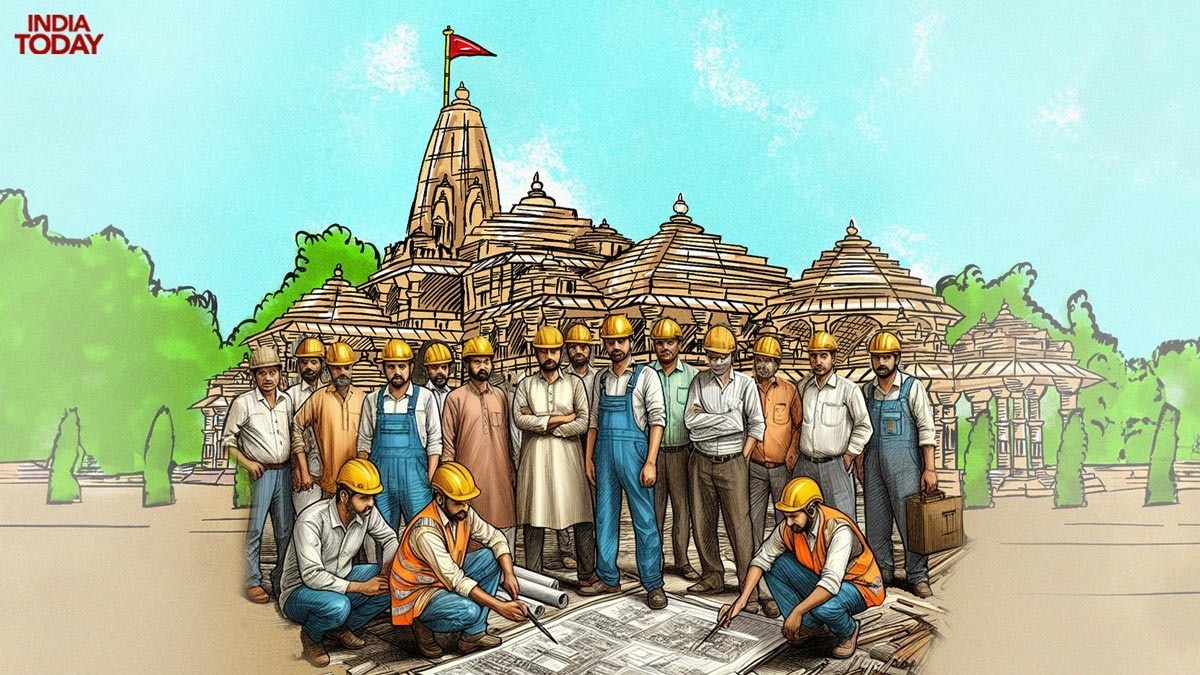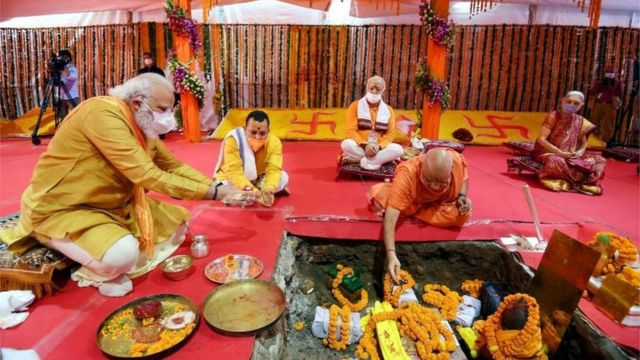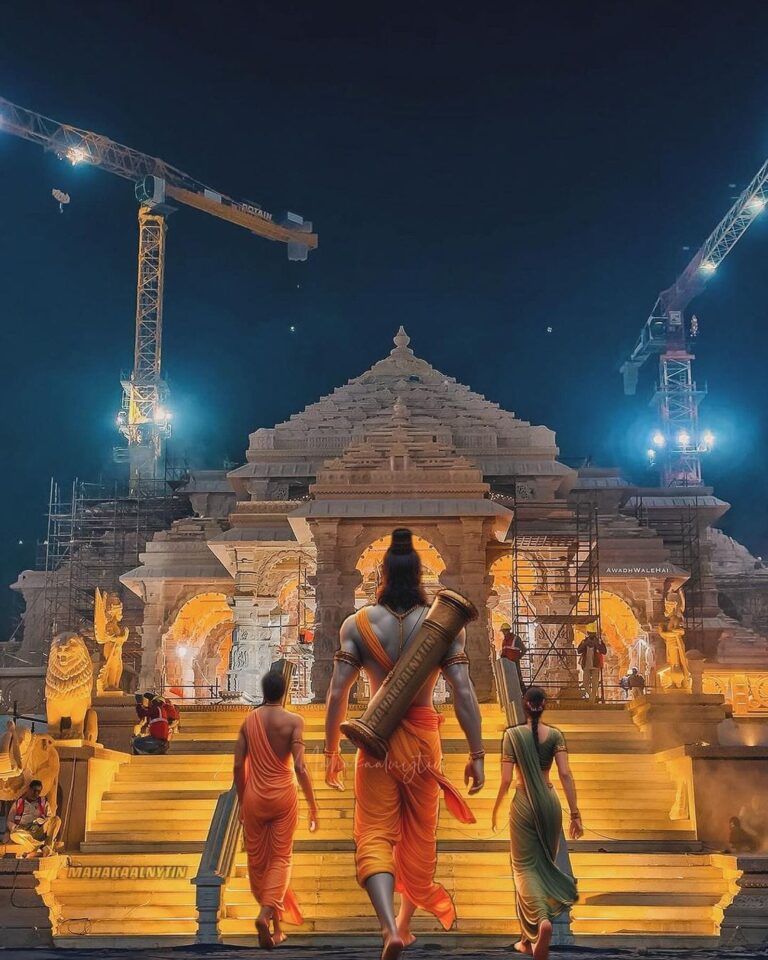Ayodhya, the town that breathes history, holds the enchanting Ram Mandir. It's not just a building, it's a living piece of our culture. Every corner whispers tales of the past, turning the temple into a haven of memories.
Ram Mandir is like a dream coming true in Ayodhya, Uttar Pradesh ,India . People believe it's where Lord Rama was born, making it super special. Getting permission for the temple was a big deal, decided by the Supreme Court verdict in 2019. Hindus got the land they wanted, and a mosque allocated land elsewhere .
The temple’s ground breaking ceremony was held on August 5, 2020, with Prime Minister Narendra Modi performing the rituals. The temple, supervised by the Shri Ram Janmabhoomi Teerth Kshetra Trust, is all set to be inaugurated in the presence of Prime Minister Narendra Modi and other dignitaries on January 22,2024. Followed by the consecration ceremony (Pran -Pratishtha) of Ram Lalla in the sanctum-sanctorum (garbha-griha), the temple will be open for the devotees from January 24.
The temple’s design, created by the Sompura family in 2020, follows Hindu architectural principles and will be one of the world’s largest Hindu temples. It features a raised platform, multiple mandapas, and intricate carvings. The deity worshiped in the temple is Ram Lalla Virajman, the infant form of Rama.
This article dives into Ayodhya's past, focusing on why this temple is a big deal and how it's finally happening.

Significance of the Ayodhya Ram Mandir for Hindus
The Ayodhya Ram Mandir is considered to be one of the most important pilgrimage sites for Hindus. It is believed to be the birthplace of Lord Ram and is considered a sacred site. The construction of the temple is seen as a symbolic victory for the Hindu community, who had been fighting for the temple's construction for decades.
The temple is expected to contribute to the development of Ayodhya as a major religious and cultural center. It is also expected to create jobs and generate economic growth in the region. The temple is expected to attract millions of devotees from across India and the world, contributing to the development of Ayodhya as a major religious and cultural center.
Historical Roots
Ayodhya, with its ancient roots deeply woven into the fabric of history, is a living chapter of India's cultural tale. More than a place on the map, it's a spot where stories of myth and reality beautifully collide.
Ayodhya isn't just old; it's a living history book. The Ram mandir is considered to be one of the most important pilgrimage sites for Hindus. Many believe it's where Lord Rama was born, adding a touch of spirituality to its ancient charm. People from all walks of life visit, seeking a connection with a glorious past.
Temple demolished' to make way for mosque – 1528:
Mughal ruler Babur’s general Mir Baqi constructed a mosque after razing a temple at ‘Ram’s birthplace’ in Ayodhya’s Ramkot. Mosque is know as “Babri Masjid”
Dispute during British India:
– Religious violence over the site of Babri Masjid in Ayodhya occurred for the first time in 1853. Under the rule of Nawab Wajid Shah of Awadh, the Nirmohis, a Hindu sect, asserted that a Hindu temple had been demolished during Babur's era to make way for the mosque.
– Six years later, the Britishers installed a fence to partition the site into two sections. Muslims were granted permission to pray within the mosque, while the outer court was designated for Hindu use.
– In January 1885, Mahant Raghubir Das submitted a request to the Faizabad district court, seeking approval to construct a canopy on the Ramchabutra, a raised platform situated outside the mosque. However, the plea was denied
Idols Emergence (1949)
Ram Lalla Idols Inside Babri Mosque – 1949
The year 1949 witnessed a profound moment in Ayodhya's history when the sacred idols of Lord Ram, known as Ram Lalla, made an unexpected appearance inside the Babri Masjid. Gopal Singh Visharad, a devout worshiper, filed a petition before the Faizabad court seeking permission to worship the deity at the disputed site.
However, the emergence of the idols sparked a legal dispute. Hashim Ansari, a resident of Ayodhya, approached the court with the plea that the idols should be removed, and the site should be allowed to remain a mosque. Despite the legal complexities, the government decided to lock the place, but priests were permitted to conduct daily puja, adding a layer of spiritual significance to this unique and contested event.
Plea Seeks Restoration of Property to Muslims — 1961
In the pages of Ayodhya's intricate history, the year 1961 marks a crucial chapter as a petitioner stepped forward, seeking the restoration of the disputed property to the Muslim community. This legal endeavor gained momentum with the Sunni Central Wakf Board filing a suit in the Faizabad civil court, officially declaring the Babri Mosque as the property of the board.
Ram Janmabhoomi Movement (1980s)
The Roar of Voices: Unveiling the Ayodhya Movement
The 1980s witnessed a groundswell of voices clamoring for the restoration of Lord Rama's birthplace in Ayodhya. This movement, known as the Ram Janmabhoomi Movement, became a defining moment in the struggle to reclaim the sacred site. Here, we unfold the chapters of this movement, exploring the motivations, leaders, and events that marked this period of fervent activism.
A committee, led by the Vishwa Hindu Parishad party (VHP), was established with the objective of "liberating" the birthplace of Lord Ram and constructing a temple in his honour.
Ayodhya court orders mosque to be opened for Hindus to offer prayers — 1986
A Significant moment occurred when responding to plea by Hari Shankar Dubey, the district judge in Ayodhya issued an order to open the gates of the contested mosque, enabling Hindus to worship there. In response, Muslims formed the Babri Mosque Action Committee in protest.
In compliance with the court's directive, the government under Rajiv Gandhi ordered the unlocking of the gates of Babri Masjid.
Prior to the court's decision, only a Hindu priest had the authority to conduct an annual puja. Following the verdict, all Hindus were granted access to the site, leading to the mosque assuming a dual role as a Hindu temple.
Vishwa Hindu Parishad(VHP) lays the foundation of Ram Temple — 1989
VHP took monumental step by initiating the construction of a Ram temple on the adjacent land to Babri Masjid. Justice Deoki Nandan Agarwal, former VHP Vice-President, filed a case requesting the relocation of the mosque. Subsequently, four pending suits in the Faizabad court were transferred to a special bench of the High Court.
KEY EVENTS
The Rath Yatra — 1990
Under the leadership of its then president, Lal Krishna Advani, the BJP organized a national Rath Yatra from Somnath in Gujarat to Ayodhya to make people aware about Ram Janmabhoomi issue and to raise support . The primary objective of this rally was to express support for the Ram Temple agitation, which was being led by the VHP at that time.
The procession included thousands of kar sevaks, or volunteers, affiliated with the Sangh Parivar. Commencing in Somnath, Gujarat, on September 25, 1990, the yatra traversed numerous villages and cities. Covering an approximate distance of 300 kilometers each day, LK Advani, leading the yatra, frequently addressed as many as six public rallies in a single day.
The Rath Yatra also led to communal violence in Gujarat, Karnataka, Uttar Pradesh, and Andhra Pradesh. On October 23, 1990, then Prime Minister VP Singh granted authorization to Lalu Prasad Yadav, the Chief Minister of Bihar, to arrest LK Advani. The then BJP president was taken into preventive custody as his procession crossed the border between Uttar Pradesh and Bihar.

Babri Mosque Demolition (1992)
On December 6, 1992 thousands of right-wing Hindu kar sevaks climbed the Babri Masjid and demolished it , in the presence of leaders from Shiv Sena, VHP, and BJP. The destruction of the mosque triggered widespread communal riots throughout the country, resulting in the loss of at least 2,000 lives during the violence.
The main issue of demolition was around the possession of the site. Various groups of Hindu organisation claimed that the Mosque was built after the demolition of the temple and also the site to be the birthplace of the Hindu deity i.e. Rama whereas Muslims claims that the Mosque was never built after the demolition but with the help of the ruins of temples.
According to Hindu Mythology, the city of Ayodhya is the birthplace of Lord Rama. The Babri Masjid-Ram Janmabhumi Disputes has become religious and political conflicts because the main issues are moving around possession of the site. The groups of Hindu organisation claim that the Mosque was built after demolishing the temple and also the site to be the birthplace of the Hindu deity i.e. Rama whereas Muslims claims that the Mosque was never built after the demolition but with the help of the ruins of temples.

Godhra train fire and Gujarat riots – 2002
On February 27, 2002 a coach no S-6 of the Sabarmati Express was returning with passengers (kar sevaks) from the Ram Janmabhoomi site in Ayodhya when it was set ablaze near Godhra railway station by a mob consisting of people from the Muslim community. As many as 59 Hindu devotees, including children, were burnt alive .The incident triggered communal riots across Gujarat claimed more than 1000 lives.


ASI conducts survey – 2003
In 2003, the Archaeological Survey of India (ASI) surveyed the disputed site and reported evidence of a significant Hindu complex beneath the mosque. However, Muslim organizations disputed these findings, leading to ongoing disagreements regarding the historical interpretation of the site.
High Court and Supreme Court Ruling
Allahabad HC divides the disputed site in three parts — 2010
In 2010, the Allahabad high court delivered its judgment on the four title suits about the dispute. The High Court ruled that the disputed land should be divided into three parts: one-third allocated to Ram Lalla, represented by the Hindu Mahasabha; one-third to the Islamic Waqf Board; and the remaining third to the Nirmohi Akhara. Subsequently, in December, both the Akhil Bharatiya Hindu Mahasabha and the Sunni Waqf Board approached the Supreme Court, challenging the High Court's decision.
All three sides approach Supreme Court — 2011
All three parties—the Nirmohi Akhara, Ram Lalla Virajman, and Sunni Waqf Board—appealed against the Allahabad High Court verdict.
The Supreme Court stayed the HC order of splitting the disputed site in 3 parts.
Supreme Court asks govt to handover land for Ram Temple construction — 2019
– On November 9, 2019, a five-judge bench of the Supreme Court issued a verdict ordering the disputed land of 2.77 acres to be transferred to a trust, to be established by the Government of India, for the construction of the Ram Janmabhoomi temple. Additionally, the court directed the government to allocate an alternative five acres of land at a different location to the Sunni Waqf Board for the construction of a mosque.
– The five-judge bench that issued the order was led by the then Chief Justice of India Ranjan Gogoi. Notably, he retired just eight days after delivering the judgment on November 17. The other four judges on the bench were Justice SA Bobde, Justice DY Chandrachud, Justice Ashok Bhushan, and Justice S Abdul Nazeer.
– The trust formed for the construction of the Ram temple was named Shri Ram Janmabhoomi Teerth Shetra. This trust comprises 15 members.
Final: Ram Lalla Mandir Construction
The Shri Ram Janmabhoomi Teerth Kshetra trust began the first phase of construction of the Ram Mandir in March 2020.The COVID-19 pandemic lockdown in India caused a temporary suspension of the construction.On 25 March 2020, Ram's idol was moved to a temporary location in the presence of the Chief Minister of Uttar Pradesh, Yogi Adityanath.In preparation for the temple's construction, the Vishwa Hindu Parishad (VHP) organised a 'Vijay Mahamantra Jaap Anushthan', in which individuals would gather at different places to chant the 'Vijay Mahamantra' – ShriRam, Jai Ram, Jai Jai Ram, on 6 April 2020. This was said to ensure "victory over hurdles" in constructing the temple.
The Consecration Ceremony (Pran-Pratistha) of Ram Mandir will be on 22 January 2024 is the date for the installation of the Lord Ram idol in the garbhagriha (sanctum sanctorum) by Champat Rai, the General Secretary of the Sri Ram Janmbhoomi Kshetra Trust. Prime Minister Narendra Modi, on 25 October 2023, was extended a formal invitation to attend the ceremony


Foundation stone laying ceremony — 2020(Bhumi Pujan)
On August 5, 2020, Prime Minister Narendra Modi laid the foundation stone for the construction of the Ram Temple. The Prime Minister also unveiled a plaque and released a commemorative postal stamp. The temple construction officially started again after a Bhumi-Pujan
The three-day long Vedic ritual was held ahead of the groundbreaking ceremony, which revolved around the installation of a 40 kg (88 pounds) silver brick as the foundation stone by Prime Minister Narendra Modi. On the day before on 4 August, the Ramarchan Puja (Puja of Shri Ram's feet) was performed, in order to invite all the major deities into the temple.
On the occasion of the Bhoomi Poojan, soil and holy water were collected from several religious places across India, such as the Triveni Sangam of the rivers Ganga, Yamuna, and Saraswati at Prayagraj, as well as the Kaveri river in its orgin at Talakaveri in Karnataka and the Kamakhya Temple in Assam.Soil was also sent from various Hindu temples, Gurudwaras and Jain temples across the nation, as well as from the four pilgrimage locations of Char Dham, to bless the temple.

Donation:
In 2021,temple trust decided to launch a nationwide "mass contact and contribution campaign" aimed at reaching 55–600 million people. Voluntary donations of Rs.1 and higher were accepted. On 1 January 2021, former President Ram Nath Kovind made the first contribution towards the construction of the Ram Mandir by donating more than Rs.5 lakh (US$6,300). Several leaders and notable personalities across the nation followed this. By April 2021, around 5,000 crore (US$630 million) was collected from donations across India. Nearly 150,000 Vishva Hindu Parishad (VHP) activists participated in collecting donations. The temple trust also received donations from the members of the Muslim and Christian communities.
Temple Design and Architectural Features
Chandrakant B Sompura and his son Ashish designed the temple complex in Nagara style architecture.
Sompura, the principal architect of the Ayodhya Ram Mandir, was first approached to design and build the temple in 1989 by Ashok Singhal, President of VHP (Vishva Hindu Parishad).
He was sent to Ayodhya to observe the site and take measurements of the space. Owing to heavy security, he had to measure the space with his feet and crafted three designs based on these dimensions. Decades later, his two sons, Nikhil and Ashish Sompura, have assisted him in the creation of the Ram Mandir.
The Ram Temple’s architecture:
The temple, constructed in the Nagara style, stands on a solid stone foundation. Approximately two lakh bricks inscribed with Lord Ram's name in various languages, collected over 30 years, are integrated into the temple structure.
The temple stands on a 12-foot jagati and an upper plinth known as the mahapeeth. The stepped shikharas rise high over the five mandapas and the one over the garba griha is the tallest at 161 feet. The kuda mandapa is three stories high. There will be 300 pillars across the mandapas and 44 teak doors.
“The doors on the ground floor are gold plated,” Ashish Sompura said. The granite stones have been sourced from Karnataka and Telangana while pink sandstone has been sourced from Bans Paharpur in Rajasthan.
The entire Ram Mandir premises spreads across 70 acres, of which the temple and the complex occupy 5.5 acres. “Initially, it was thought that we have to create a boundary or perkota which is kind of a protective boundary wall for the safety of the temple,” Ashish notes.
“Instead, the Trust and us decided to have a Vishnu Panchayatan where five temples, of Hanuman, Durga, Ganesha, Shiva, and Surya, will be there. On the northern side of the temple where Sita’s Rasoi was there (it got destroyed during the Babri Masjid demolition), we have made a kitchen where Lord Ram’s bhog will be made and there is also an Annapurneshwari Temple. So, there will be six temples in all apart from the Ram Mandir."
The Nagara Style of architecture
The Nagara style emerged in North India around the late Gupta period. Typically, temples made in this style of architecture are built on a raised platform along with the sanctum sanctorum, above which stands the most distinguished feature of the Nagara style — the shikhara (meaning mountain peak). Most Nagara-style temples have murals and engravings adorning the walls and have a circumambulatory passage surrounding the sanctum sanctorum (where the deity is kept).
One must note here though, straying away from Nagara architecture, a 732-metre-long wall has been built around the Ram Mandir complex. In most authentic Nagara-style temples, a distinctive boundary wall such as a gopuram, is usually absent.

Ram Mandir Ayodhya Controversies
Controversies surround the temple, including allegations of donation misuse, sidelining of activists, and politicization by the BJP. Historical disputes date back to the construction of the Babri Masjid in the 16th century, which was demolished in 1992, leading to inter-communal violence.
The temple’s construction faced challenges, including a temporary suspension due to the COVID-19 pandemic. Despite controversies, the project received donations from various communities, and as of December 2023, significant progress has been made, with the consecration ceremony planned for January 22, 2024.
Controversies also involve alleged donation scams, sidelining of major activists, and politicization by the BJP. The consecration ceremony faces objections from some religious leaders, while the temple’s construction has been criticized for its design and alleged Muslim involvement.
The “Mandir wahi banayenge” slogan, meaning “The temple will be built exactly there,” has been a central theme in the Ram Janmabhoomi movement and signifies hope for the construction of the temple. The slogan has become part of cultural expressions, stand-up comedy, and political discourse.
Pran Pratishtha Ceremony (Consecration)
In preparation for the pran pratishtha ceremony, the Government of Uttar Pradesh has earmarked 100 crore for Ramotasav.
Pran Prarishtha is on January 22, 2024. This event promises to be a momentous occasion, not only for the devotees but for the nation as a whole. The ceremony is expected to draw over 7,000 guests from India and over a lakh devotees to Ayodhya. Prime Minister Narendra Modi will lead the consecration ceremony, and the temple’s opening is timed to occur just months after the groundbreaking ceremony. The historic event will be attended not only by our Prime Minister Narendra Modi but also by other dignitaries including UP CM Yogi Adityanath, RSS chief Mohan Bhagwat, UP Governor Anandiben Patel, and president of the temple trust Mahant Nritya Gopal Das.
The Pran Pratishtha ceremony for the Ram Mandir in Ayodhya started on January 17 and will conclude on January 22, 2024. The historic inauguration of the temple which includes the Pran Pratishtha ceremony, will take place between 12:20 PM and 12:45 PM on January 22, 2024. This ceremony involves the infusion of the idol with the divine life force, making it a living representation capable of receiving prayers and bestowing blessings.


AYODHYA RAM MANDIR SEVEN-DAY RITUAL – FULL SCHEDULE
- On January 16, the temple trust appointed a host, Shri Ram Janmbhoomi Teerth Kshetra, who conducted the atonement ceremony, featuring the 'Dashvidh' bath, Vishnu worship, and offerings to cows along the Saryu River.
- Then the next day on January 17, a procession carried the idol of Lord Ram in his child-like form (Ram Lalla) to Ayodhya, with devotees bearing Saryu water in Mangal Kalash enroute to the Ram Janmabhoomi temple.
- Formal rituals commenced on January 18 with Ganesh Ambika puja, Varun puja, Matrika puja, Brahmin Varan, and Vastu puja.
- On January 19, the lighting of the holy fire was followed by the establishment of 'Navagraha' and a 'havan'.
- On January 20, the sanctum sanctorum of the temple was washed thoroughly with the holy water of Saryu, after which there were Vaastu peace and Annadhivas rituals.
- The ritual on January 21 involves a divine bath with 125 urns, culminating in Shayadhivas, where the Ram Lalla idol is bathed and laid to rest.
- January 22 will begin with a morning puja and the consecration of the Ram Lalla deity in 'Mrigashira Nakshatra' during the afternoon Pran Pratishtha at 12:20 PM followed by an 'aarti'.

Conclusion
The construction of the Ayodhya Ram Mandir is a significant event in history, combining elements of spirituality, resilience, and tradition. From past controversies to the groundbreaking ceremony, this journey showcases the unwavering devotion of the people.
The Ayodhya Ram Mandir has been the center of a long-standing religious and political dispute in India. However, with the construction of the Ram Janmabhoomi temple, the dispute has been settled, and the site has been restored to its rightful owners. The temple is a beacon of hope and inspiration, reminding us of the power of faith and the strength of the human spirit. The temple promises to be a place of spiritual and cultural awakening. It is a monument to India's rich cultural and religious heritage, and a testament to the enduring legacy of Lord Shri Ram.
The Ayodhya Ram Mandir represents not only a beautiful structure but also a symbol of unity in diversity. It reflects the aspirations of millions, transcending religious boundaries and embracing our shared cultural heritage. This temple invites us to reflect on the diverse cultural fabric of India. Its construction, despite challenges and controversies, demonstrates our collective determination to honor Lord Rama's birthplace.
As we eagerly await the Pran Pratishtha ceremony, the Ayodhya Ram Mandir stands as a symbol of hope, offering a peaceful sanctuary that embodies our enduring spirit of harmony. It is more than just an architectural marvel; it is destined to become a sacred space that resonates with the soul of our nation, echoing the sentiment, "Mandir wahi banayenge" – we will build the temple there.

